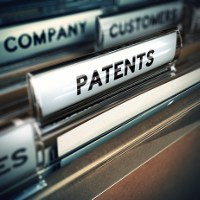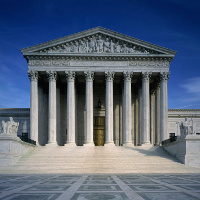 What if there is a way for a patent applicant to obtain a “gold-plated patent” that is immune to administrative cancellation before the Patent Trial and Appeal Board (PTAB) at the U.S. Patent and Trademark Office (PTO)? This intriguing notion is the subject of a recent paper by Professor Michael S. Greve of Scalia Law, titled Exceptional, After All and After Oil States: Judicial Review and the Patent System and published in the Winter 2020 edition of the Boston University Journal of Science and Technology Law. Prof. Greve presented an early draft of this paper at the “Perspectives on the PTAB: The New Role of the Administrative State in the Innovation Economy” conference that was co-hosted by CPIP and the Gray Center at Scalia Law.
What if there is a way for a patent applicant to obtain a “gold-plated patent” that is immune to administrative cancellation before the Patent Trial and Appeal Board (PTAB) at the U.S. Patent and Trademark Office (PTO)? This intriguing notion is the subject of a recent paper by Professor Michael S. Greve of Scalia Law, titled Exceptional, After All and After Oil States: Judicial Review and the Patent System and published in the Winter 2020 edition of the Boston University Journal of Science and Technology Law. Prof. Greve presented an early draft of this paper at the “Perspectives on the PTAB: The New Role of the Administrative State in the Innovation Economy” conference that was co-hosted by CPIP and the Gray Center at Scalia Law.
Examining the PTAB through his administrative law lens, Prof. Greve spots what he calls a “Sandy,” that is, a hypothetical, newly discovered relative of an ancient animal species that was thought to have gone extinct. This clever conceit with “Sandy,” which runs through the paper, refers to a Section 145 action to obtain a patent in the Eastern District of Virginia. This particular “Sandy,” Prof. Greve explains, “is unknown to, and greatly at variance with, contemporary administrative law, which operates on the principles of agency adjudication and deferential, on-the-record appellate review.” He argues that Article III prevents a patent obtained through a Section 145 action from subsequently being cancelled at the PTAB—in other words, “Sandy” gives a successful plaintiff a “gold-plated patent.”
To set the stage, Prof. Greve runs through the history of Section 145, placing it within the Patent Act’s current statutory scheme for reviewing validity determinations and the administrative state more broadly. A vestige of the Patent Act of 1836, Section 145 provides that an “applicant dissatisfied” with an appeal to the PTAB following an examiner’s rejection “may . . . have remedy by civil action” against the Director of the PTO. If the court adjudges “that such applicant is entitled to receive a patent for his inventions,” the “adjudication shall authorize the Director to issue” the patent. The alternative pathway for a “dissatisfied” applicant is an appeal directly to the Federal Circuit under Section 141.
The two provisions are markedly different. An applicant that chooses a Section 141 appeal to the Federal Circuit waives the right to proceed under Section 145 before the district court. Like agency adjudication generally, a Section 141 appeal is on the record—no new evidence may be introduced—and deference is given to the PTAB. The decision is then remanded to the PTO for further proceedings. Section 145 actions, by contrast, allow the introduction of new evidence, and the district court can adjudicate validity de novo—without deference to the PTAB. If the plaintiff is successful, the district court directs the PTO to issue the patent. According to Prof. Greve, the lack of deference to the PTO and the ability to introduce new evidence seems foreign—a mythical creature in the modern administrative state.
Turning to the case law, Prof. Greve looks at Dickinson v. Zurko, where the Supreme Court in 1999 held that the Federal Circuit must follow the Administrative Procedure Act (APA) framework when reviewing the PTO’s findings of fact in a Section 141 appeal. The Federal Circuit had applied the Federal Rules of Civil Procedure, which state that a reviewing court must not set aside a district court’s factual findings unless they are clearly erroneous. The Court held that the more deferential review standard of the APA should instead be applied to the PTO. As Prof. Greve explains, the Federal Circuit later extended the Court’s holding, thus directing district courts to apply a deferential standard of review to the PTO’s factual findings in a Section 145 action.
This push to impose the APA standard of review onto Section 145 was short lived. In 2012, the Supreme Court in Kappos v. Hyatt rejected the notion that background principles of administrative law dictate that Section 145 requires a district court to review the PTO’s factual findings deferentially. The Court also rejected the argument that plaintiffs in Section 145 actions should be permitted to introduce new evidence only if they did not have the opportunity to present it to the PTO. Thus, Section 145 plaintiffs may introduce new evidence subject only the ordinary rules of evidence and procedure, and the district court may review these new facts de novo. In other words, appeals under Section 141 are very different than direct actions under Section 145. As Prof. Greve remarks of Hyatt, “Welcome back, Sandy.”
In Oil States v. Greene’s Energy, the Supreme Court in 2018 laid to rest the argument that an inter partes review (IPR) before the PTAB violates Article III. Invoking the public rights doctrine, the Court characterized an IPR as the PTAB’s decision to reconsider the PTO’s earlier grant of a patent—not as a decision to annul a property interest that has already vested. This same sort of reasoning, Prof. Greve points out, has led to decisions that allow the PTAB to cancel patents that have been upheld in infringement actions before the federal courts. He argues that those decisions are inapplicable when it comes to a “gold-plated patent” under Section 145—an issue that surprisingly has not yet been litigated. Such patents, Prof. Greve asserts, cannot be revoked by the PTAB under Article III.
Prof. Greve explains that the validity of a patent cannot conclusively be established in an infringement action in the federal courts. Indeed, this explains why subsequent PTAB cancellations are constitutional. However, the same is not true for patents secured in a Section 145 action. Under Hyatt, Prof. Greve contends, a successful plaintiff is entitled to the patent “as a matter of right,” and the unsuccessful Director of the PTO, by contrast, is “duty-bound” to issue the patent. Unlike with infringement actions, the very point of a Section 145 action is to conclusively establish the patentability of the claims at issue. And this difference, Prof. Greve avers, is critical. Section 145 patents are issued “as the consequence of a conclusive, binding judgment of an Article III court,” and Supreme Court case law prevents final judgments of Article III courts from being “subject to executive revision.”
Prof. Greve explains:
If the issue of subsequent administrative cancellation of a Section 145 patent were to reach the Supreme Court, Prof. Greve believes that the Court will reaffirm the “gold-plated” nature of such a patent in light of Hyatt. He further suggests that if this is true, it seems likely that more applicants will choose the Section 145 route. As things are now, very few people choose this option. Indeed, presumably to discourage the filing of such actions, the PTO recently took the position that Section 145 plaintiffs must pay the pro-rated salaries of the government’s lawyers—a notion the Supreme Court rejected last year in Peter v. Nantkwest. Regardless, a Section 145 action before the district court and the inevitable appeal to the Federal Circuit are risky, expensive, and time-consuming. However, if this route really does produce a “gold-plated patent” that the PTAB cannot strike down, Prof. Greve predicts that “Sandy may yet shine a light into our stoned faces.”
 By
By